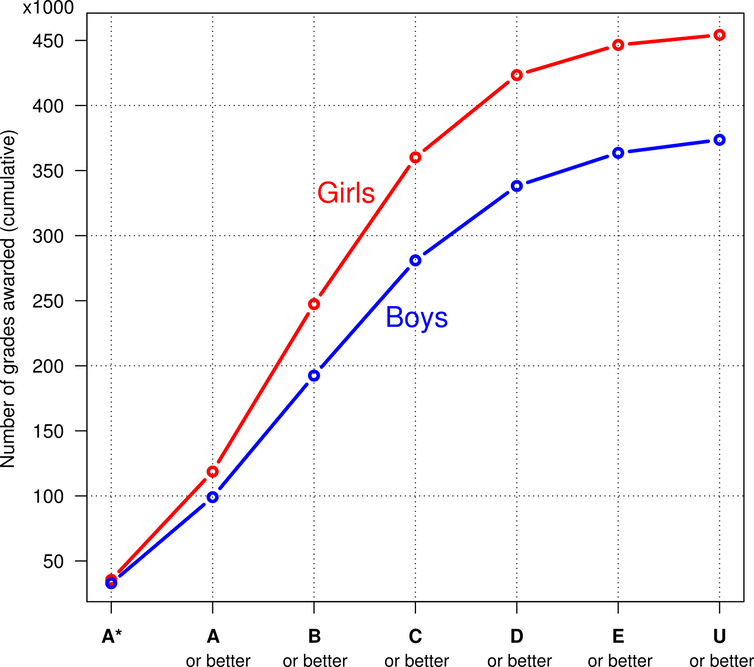It’s a myth that boys have beaten girls in A-level results

Anyone who knows about the educational underachievement of boys compared to girls will have been surprised by the headlines about the 2017 A-level results. The Telegraph wrote that “boys are beating girls” and spoke of a “dramatic reversal”. The Belfast Telegraph also reported that “boys emerged as the winners in this summer’s results”, while the BBC’s article, with the headline “boys help to raise A-level grades” stated:
In A* and A grades, boys have moved ahead of girls, with 26.6% of boys getting these results compared with 26.1% of girls, reversing a 0.3% gap last year.
The change is significant because girls outperform boys at every stage of their education, and have been performing better at the top grades at A-levels for 17 years.
But despite all these celebratory headlines, having looked in detail at gender differences in the available data, it seems this isn’t actually the turning point for boys that was so widely reported at all. Let me explain.
“In 30 of the 39 subjects listed, the percentage of boys receiving a top grade was lower than that of girls. The reported overall lead of boys is mostly due to their better scores in chemistry (3.5 percentage points lead) and mathematics (1.8 percentage points lead).”
The analysis
My analysis shows that the biggest trend in the A-level results data is that – just the same as previous years – far fewer grades have been awarded to boys (373,654) than to girls (454,701). In other words, boys only sat 45% of all A-levels – a percentage that is similar to the university enrolment gap.
To illustrate the significance of this, I put together a graph (below) which shows the number of A-levels awarded to boys and girls for each grade level. You see that roughly the same number of A* grades go to boys and girls. But that more girls than boys achieved an A grade or higher – and even more girls received a B grade or higher.
Number of grades awarded by grade level and gender. For example, boys received around 281,000 grades at C or above, compared to around 360,000 for girls.

The general under-representation of boys across grades is not the only problem. In 30 of the 39 subjects listed, the percentage of boys receiving a top grade was lower than that of girls. The reported overall lead of boys is mostly due to their better scores in chemistry (3.5 percentage points lead) and mathematics (1.8 percentage points lead). The other seven subjects where boys have the lead – were less popular subjects such as critical thinking (only 45 students took critical thinking), German, French, communications studies and computing – which are chosen by far fewer students and so the data have less of an effect on the total average.
Why girls do better
Girls have, generally speaking, better adjusted to the academic environment than boys, which is often why they do better in exams. Even so, at A-level, girls remain considerably under-represented in most STEM subjects – except chemistry and biology.
The uptake of mathematics by girls has stagnated at just under 40% for years. We know that girls may lack confidence in mathematics, despite possessing good ability. This has led some to suggest making the critically important subjects such as mathematics and English compulsory – although this introduces new challenges.
The big question is why far fewer boys than girls decide to take A-levels and go to university. A-levels are obviously not for everyone, but it is unclear why this applies more to boys than to girls. The same is true for the International Baccelaureate, with only 44% of boys achieving this qualification last year.
Analysis from this and previous years’ GCSE results also shows that boys continue to fall behind in nearly all subjects. So it is not completely surprising that more boys than girls try to find alternatives to A-levels. There aren’t any reliable data on where these boys are actually going, so what they are doing instead of A-levels is a bit of a mystery.
“it’s certainly not the case that “boys have moved ahead” of girls. The half a percentage point advantage in the top A and A* grades is meaningless in the broader context of boys’ severe under-representation across A-levels, and their falling behind in most subjects.”
Boys are still behind
What all this shows is that it’s certainly not the case that “boys have moved ahead” of girls. The half a percentage point advantage in the top A and A* grades is meaningless in the broader context of boys’ severe under-representation across A-levels, and their falling behind in most subjects.
This under-representation is a continuation of poorer performance by boys across all educational stages before A-levels. We also have seen far more behavioural problems in boys than in girls, which may even lead to expulsion – this may play a part in the wider picture.
These issues need urgent attention, but this isn’t just a task for parents and schools alone. This is something that needs to be tackled across the board – with a whole society approach. But more than anything we just need to start taking this problem more seriously.
This article was originally published on The Conversation. Read the original article. The article was then published on the Male Psychology Network website in 2017.
Scroll down to view comments
Disclaimer: This article is for information purposes only and is not a substitute for therapy, legal advice, or other professional opinion. Never disregard such advice because of this article or anything else you have read from the Centre for Male Psychology. The views expressed here do not necessarily reflect those of, or are endorsed by, The Centre for Male Psychology, and we cannot be held responsible for these views. Read our full disclaimer here.

.
Gijsbert Stoet is a Professor of psychology at the Department of Psychology, University of Essex (England). His publications cover cognitive neuroscience, cognitive psychology, the psychology of religion, and education. He maintains the website genderequality.info.













































